 Household Heroes: Home First Aid
Household Heroes: Home First Aid
Whether you’re living alone, sharing a home with others, or taking care of a family, emergencies can happen at any moment. From minor mishaps like scrapes and burns to more serious incidents that could potentially be life-threatening, having a comprehensive understanding of home first aid can be invaluable. This knowledge, combined with a well-stocked first aid kit, empowers you to react effectively to a wide range of emergencies. This article will guide you through the essentials of home first aid, equipping you with the knowledge and confidence to take immediate action when it matters most.
Why Home First Aid Matters
Accidents can occur anywhere, at any time even in the safest homes. One moment, you could be preparing dinner while your kids are playing around, the next, a cry of pain fills the room.
Knowing how to respond effectively in these situations can not only mitigate the severity of an injury or illness but can also be the difference between life and death. Basic first aid skills such as knowing how to perform CPR, stop bleeding, or even how to correctly clean and bandage a wound can greatly improve outcomes. Being equipped with the essential first aid items for home use can greatly improve patient outcomes.
Steps for First Aid: The Three P’s to Remember
Dealing with emergencies can be overwhelming but remembering the Three P’s of first aid – Preserve life, Prevent further injury, and Promote recovery can serve as a guiding principle for anyone faced with an emergency situation.
Let’s break down what the The Three P’s steps mean:
Preserve life: The first and most crucial step in first aid. Check the victim’s airway, breathing, and circulation. If they are unresponsive orstruggling, call your local emergency services immediately.
- Prevent further injury: If possible, move the person to a safer location. This step can also involve tasks like cleaning wounds to prevent infection or immobilizing a suspected broken bone.
- Promote recovery: Once immediate danger has passed, your role switches to comfort and support. This could include dressing wounds, applying ice to a sprain, or simply reassuring the person help is on the way.
These Three P’s can be used as a guide for emergency situations, helping you prioritise your actions and make effective decisions under pressure. Remember, the goal is to preserve life, prevent further harm, and promote recovery.
What Should A Home First Aid Kit Include?
Now, let’s talk about your home first aid kit. What does a first aid kit need to include? A first aid kit should include the necessary items for treating common injuries. The extensive range of Aero First Aid Kits provide the necessary components required for workplace first aid kits and home first aid kits.
Here’s a list of the top 15 items to include in a home first aid kit:
- Adhesive Bandages: Various sizes for covering small cuts, blisters, or abrasions.
- Sterile Gauze Pads and Adhesive Tape: For covering and cleaning wounds, as well as a padding for blisters or wounds.
- Antiseptic Wipes or Solution: To clean wounds before bandaging.
- Tweezers: For removing splinters or other foreign objects.
- Scissors: To cut tape, gauze, or clothing.
- Disposable Gloves: To protect yourself and others when giving first aid.
- Pain Relievers: Over-the-counter medications like paracetamol or ibuprofen.
- Thermometer: To check body temperature in cases of fever.
- Emergency Blanket: For warmth in shock and exposure situations.
- First-Aid Manual or Instruction Booklet: To provide guidance during emergencies.
- Resuscitation Mask or Face Shield: To make CPR safer.
- Instant Cold Packs: For cooling injuries or burns.
- Hydrocortisone Cream: For rashes or itching.
- Plastic Bags: For disposal of contaminated materials.
- Flashlight and Extra Batteries: For emergencies where light is needed.
As well as the items included above, additional items can be added depending on your personal or family needs. It’s also essential to routinely check your first aid kit to replace used items or medicines that have expired.
Need help with your Workplace Safety too?
We’ve got you covered!
Download your free Guide to First Aid in the Workplace below…
Aero Healthcare: Your Partner in Home First Aid
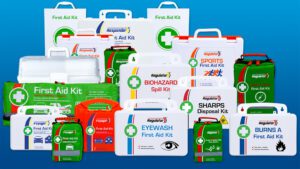
Explore our range of First Aid Kits
Be Prepared, Be a Hero
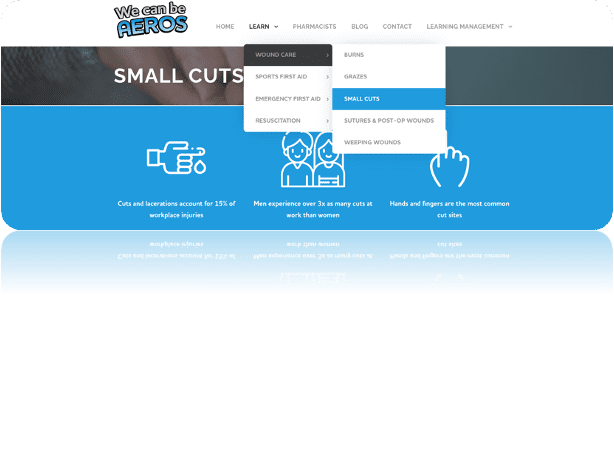
Start by learning the basic steps of first aid, put together a home first aid kit, and remember, we at Aero Healthcare are always here to help you in your journey.
CPR: A Lifesaving Procedure Everyone Should Know
With an estimated 25,000 cases occurring out-of-hospital each year, sudden cardiac arrest (SCA) presents as one of the most prevalent health risks facing Australians today. However, it is possible to significantly increase cardiac arrest patients’ chance of survival through the immediate delivery of CPR (cardiopulmonary resuscitation) and defibrillation as part of the chain of survival. Early defibrillation is often considered to be the most important measure as it is the only way to restore the patient’s normal heart rhythm.
What causes Sudden Cardiac Arrest?
The most common cause of Sudden Cardiac Arrest is Ventricular Fibrillation, which is an irregular heart rhythm. To learn more about Sudden Cardiac Arrest, read our article Sudden Cardiac Arrest – The Silent Killer
How is sudden cardiac arrest treated?
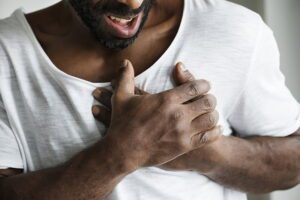
The first step in the chain of survival is Early Access. Identify the situation as a sudden cardiac arrest by checking the victims breathing and consciousness. Once a Sudden Cardiac Arrest has been established, an ambulance must be called immediately to ensure defibrillation and life support arrive as soon as possible.
The second step is Early CPR. If Cardiopulmonary Resuscitation (CPR) begins within 4 minutes, then vital organ function such as the brain can be maintained. The sooner CPR is conducted the greater the chance of survival. Any attempt at resuscitation is better than no attempt. CPR should be performed at a rate of 100/120 chest compressions per minute. This is the same rate as the beat of the song ‘Staying Alive’. After every 30 compressions, give two rescue breaths CPR should be continued until trained emergency service professionals, or an AED arrives. If you have never performed CPR before, it can sound daunting – but don’t worry! Many training organisations run courses and have manikins available to learn and practice CPR safely.
The final step in the chain of survival is Early Defibrillation. If early defibrillation is applied there is a significant increase in the chance of survival. A defibrillator will administer a controlled electric shock, to allow restoration of the normal heart rhythm.
The Silent Killer, Sudden Cardiac Arrest can strike anywhere, anytime. It’s important that all Australians are prepared with the knowledge and equipment for when it strikes. Knowing what to do and providing a quick response is crucial for achieving the greatest chance of survival.
Anyone Can Use a Defibrillator – Learn How…
Medicine Cabinet Essentials To Have
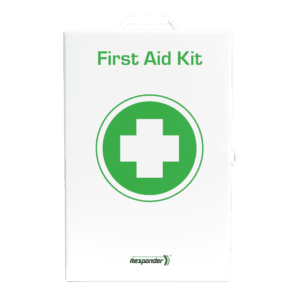
- Antihistamines: For allergic reactions and bug bites.
- Pain relievers: Such as acetaminophen or ibuprofen.
- Antacids: For heartburn or indigestion.
- Hydrocortisone cream: To relieve itching and minor skin irritations.
Always remember to check the expiration dates on these medications and replace them as necessary. Also, always use these medicines as directed on the label, and when in doubt, consult a healthcare professional. Your local pharmacist can recommend the required over the counter medicines needed for your situation. Use a suitable cabinet or case to keep all your first aid materials and medicines safe and accessible at a moments notice.
Dealing with Burns at Home
Burns can happen from a simple cooking accident or even a candle left unattended. It is important to act swiftly when a burn occurs to maximise the recovery time and reduce the impact of the injury.
How Should You Treat A Burn At Home?
The Here are the immediate steps to take in case of minor burns:
- Cool the burn: Run cool (not cold) water over the burn for about 10-15 minutes or until the pain decreases.
- Apply a burn cream or aloe vera gel: AeroBurn Gel provides, cooling relief to the burn site. This will soothe the burn and promote healing.
- Cover the burn with a non-stick, sterile bandage.
- Relieve pain with OTC pain relievers.
For more serious burns, seek immediate medical help. Do not try to burst any blisters as this can lead to infection.
Browse Aero’s range of burn gels
First Aid Misconceptions: Common FAQs
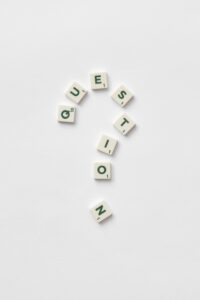
- Should I put butter on a burn? No. This can trap heat and increase the risk of infection. Use cool water and a sterile bandage.
- Should I induce vomiting if someone swallows poison? No. This can cause more harm. Instead, call Poison Control or your local emergency services immediately.
- Should I pull out an object if it’s impaled in the body? No. This could lead to more damage or severe bleeding. Try to immobilize the object if possible and seek immediate medical help.
Remember, proper knowledge of first aid is just as crucial as having a well-stocked first aid kit. It can make a real difference in an emergency situation, potentially saving a life before medical help arrives.


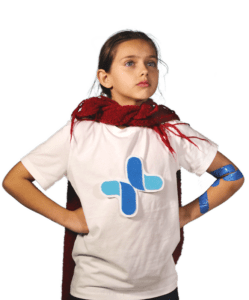 Household Heroes: Home First Aid
Household Heroes: Home First Aid  Preserve life: The first and most crucial step in first aid. Check the victim’s airway, breathing, and circulation. If they are unresponsive orstruggling, call your local emergency services immediately.
Preserve life: The first and most crucial step in first aid. Check the victim’s airway, breathing, and circulation. If they are unresponsive orstruggling, call your local emergency services immediately.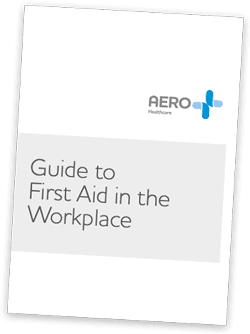
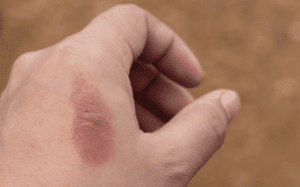
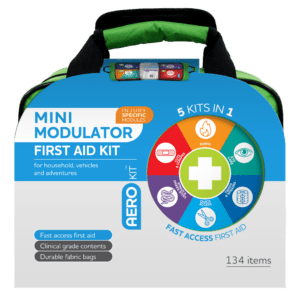 Introducing the NEW Mini Modulator - perfectly sized for taking on your next adventure!
Introducing the NEW Mini Modulator - perfectly sized for taking on your next adventure!
